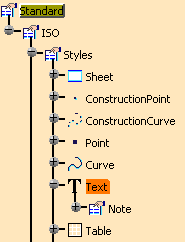Setting default values for elements using styles
Styles enable administrators to set the default values that will be applied to all properties of such elements as sheets, geometry, annotations, dimensions, dress-up and dress-up symbols, callouts, etc.
The default values are defined and stored in the standard XML file, where a set of new parameters are defined, one parameter for each element property whose default value can be set.
Default values are applied to elements as they are created. After creation, the user can modify element values as required.
If you modify styles in the standard itself and then update the standard file used by the drawing, the elements which have already been created will NOT be modified (i.e. their default values will remain as previously). Updating the standard will only have an impact on the next elements to be created.
When you create a drawing a sheet style is applied to the first
sheet. If you create a new sheet, the properties of the first sheet are
copied and applied to it. No sheet style is applied. By default, the
Sheet Style combo box available through File > Page Setup is
empty so updating the standard will not apply any sheet style.
Styles replace the former management of default values (which was performed using the Set as Default / Use Default functionalities), for drawings:
-
created with version V5 R11 and later
-
created with versions up to V5 R10, whose standard has been updated in V5 R11
For drawings created with versions up to
V5 R10 and NOT updated, default values still use the Set as Default / Use
Default functionalities. For more information, refer to Setting Properties
As Default and Using Properties Set as Default.
Defining default values
The default values for all element properties are stored in a specific Styles section of the standard XML file, and are defined by the administrator.
Styles are defined for all Drafting element types. By default, one style named Default is predefined in the standard files for each type of element. In this Default style, all element properties are pre-defined, enabling the administrator to set the value for this property. This Default style cannot be renamed.
You can create your own styles (based on existing styles), as well as delete styles (providing there remains at least one style for each type of element).
Using default values
When creating a Drafting element, default values are automatically used. So, when users select a command that creates a specific type of element, the Style toolbar displays the current style for this type:
- If only one style is defined for this type of element, then this style is displayed in the toolbar.
- If several styles are defined for this type of element, then a style is defined as the current style and is displayed in the toolbar. Users can use the toolbar to select another style of the same type before creating the element.
The toolbar reflects the value of the style, but users can always modify the value of specific elements.
Re-applying a style to an object
When a Drafting element is selected, the Style toolbar displays the list of the styles that can be applied to it. If the user selects one of these, this style is re-applied to the element. This enables users to reset to its default values an element whose properties have been modified.

Customizing Styles
Note that a new style is always based on an existing style.
![]()
-
Expand the Styles node in the editor.
-
Select the Text node.
-
Click on the Create style button in the right-hand pane. The Create style dialog box is displayed.
-
Type the name of the new style in the appropriate field.
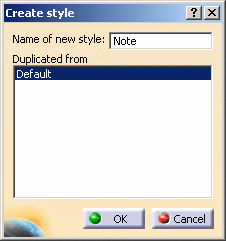
The Duplicated from list is used when several styles exist for a given type of element to specify which existing style the new style should be based on. In our example, only the Default style exists. Therefore, the new style will be created based on this Default style.
-
Click OK. A new style called Note is added under the Text node in the editor.
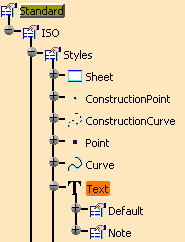
-
Expand the Note > Font node in the editor, and then select the Name node.
-
Type Verdana in the Name field in the right-hand pane.

-
Expand the Text node in the editor, and then select the Frame node.
-
Choose Rectangle from the Frame drop-down list in the right-hand pane.

-
Click OK to save your modifications and exit the standards editor.
-
Now, start creating a new text in a sheet. In the Style toolbar, you can notice that two styles are now available: Default and Note.
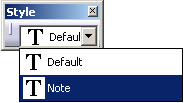
-
Choose the Note style, click on the sheet to indicate where you want to position the note, type your note in the text editor and then click OK. The note is creating using the values you specified.

-
You will now delete the Default style. To do this, launch the standards editor again.
-
Expand the Styles node and then select the Text node.
-
Click on the Delete style button in the right-hand pane. The Delete style dialog box is displayed.
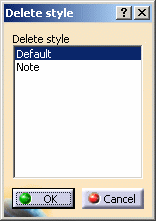
-
Select Default as the style that you want to delete, and click OK. The Default style is deleted from the Text node in the editor.
